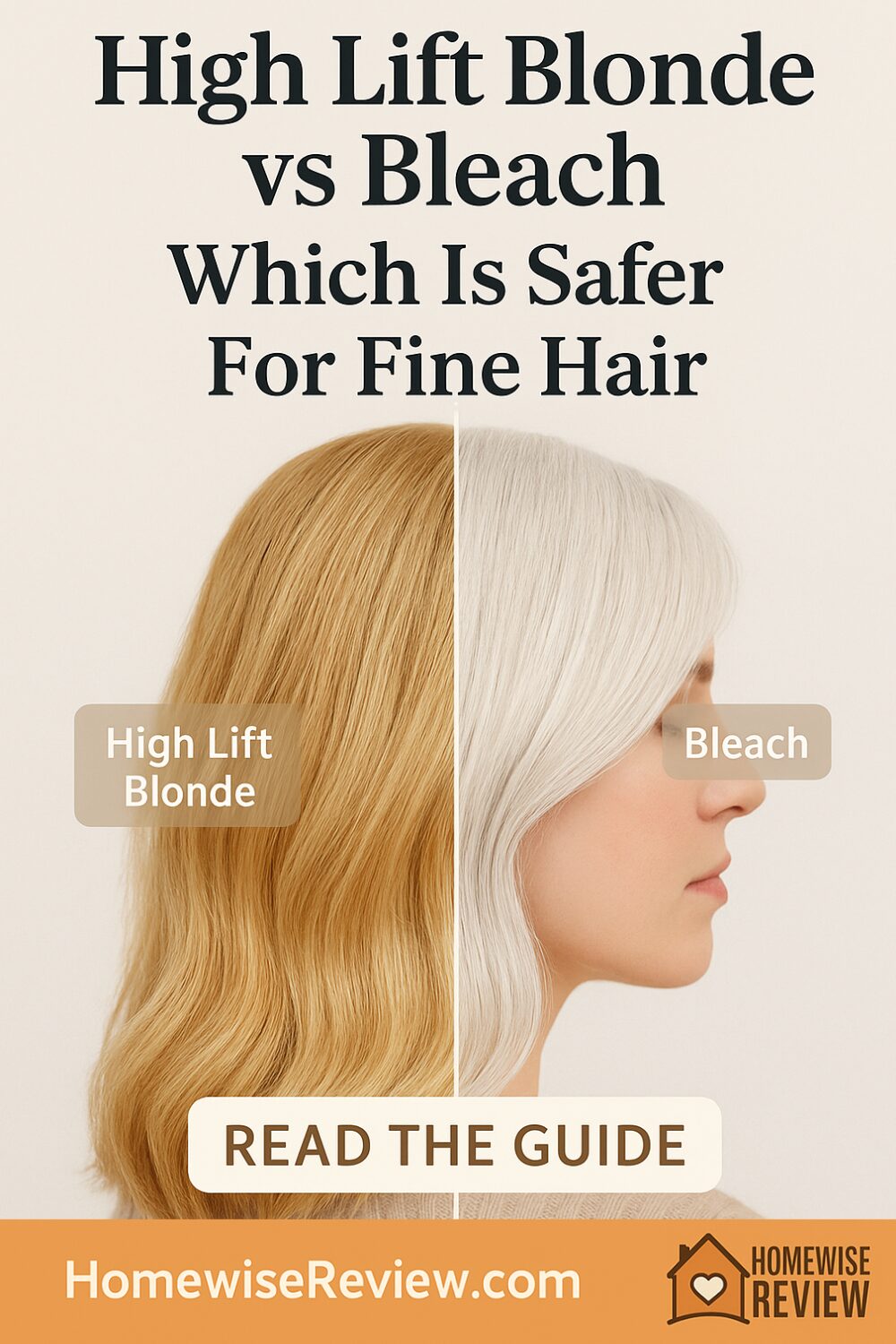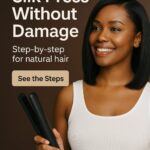
Fine hair can look delicate and airy, but it is also easier to snap, frizz, or overprocess. Going blonde pushes that even more. A lot of people with soft, skinny strands want to go lighter but are nervous about bleach, so they ask about high lift blonde color instead. Both options can work, but they are not the same, and one is usually kinder to fragile hair than the other. This guide walks through how each method works, what causes breakage, and how to pick the least damaging path for your hair goals.
Why fine hair is so easy to damage when you go blonde
Fine hair is not just “thin.” Each individual strand has a smaller diameter and often a thinner cuticle layer. The cuticle is the outer shell of the hair that protects the inside. When that cuticle gets roughed up too much, the strand frays, gets rough at the ends, or snaps off. Lightening is one of the fastest ways to stress that cuticle, because you are forcing pigment out of the hair instead of just coating it with dye.
Here is the problem. Fine hair usually lifts quickly, which sounds convenient, but it also means it can tip from “almost there” to “fried” fast. You do not always get that cushion thicker hair has, where it can tolerate a little more processing. Once fine hair is compromised, you tend to see breakage around the hairline, temples, and crown first. Those are the areas most people want bright and clean blonde, which makes it tricky.
Because of this, the real question is not “Which one lifts more, high lift or bleach,” but “Which one gives you the blonde you want with the least structural trauma to already delicate strands.”
What high lift blonde color actually does
High lift blonde color is a permanent dye formula designed to lighten and tone in one step. It typically uses a higher level of ammonia plus a stronger developer (often 30 volume, sometimes 40 volume in salon use), and it works by pushing natural pigment out of the hair while depositing blonde tones at the same time. So instead of bleaching first, then toning after, you are lifting and shifting the tone in one go.
For someone starting at a dark blonde or light brown base, high lift can give you two to four levels of lift. On fine hair, that lift can sometimes look even brighter than expected because fine strands reflect more light and can appear paler than they technically are. The finish is usually warmer at first, so think soft golden or honey, not icy platinum. A toner or purple shampoo usually brings it closer to neutral.
The big reason people with fine hair ask about high lift is that it sounds “gentler than bleach.” In general, high lift color can be less extreme than traditional bleach because it is still technically hair dye, not a straight-up lightener. But that does not mean it is mild. High lift blonde formulas still swell the cuticle, still dissolve pigment, and still weaken the hair. On very fine hair, especially if it is fragile at the ends or already colored, high lift can absolutely cause dryness, rough texture, and snapping.
What bleach does and why it is harsher
Bleach is more direct. Bleach does not try to color-correct at the same time. Its whole job is to break down natural pigment so light can pass through. It usually gets mixed with a developer (10, 20, or 30 volume depending on how aggressive the lift needs to be). Bleach can take hair multiple levels lighter, even from dark brown to pale yellow, which is why it is still the go-to for platinum and cool blonde.
The downside is predictable. Bleach blows the cuticle wide open and eats through pigment fast. If it is left on too long or applied repeatedly to the same area, the inner structure of the hair starts to weaken and hollow out. On fine hair, that can show up as gummy texture when wet, jagged ends that refuse to smooth down, and hairline pieces that just refuse to grow past chin length.
Another thing to keep in mind is overlap. Bleach on regrowth can be OK if you are only applying it to new hair that has not been lightened before. Bleach on previously lightened ends is where fine hair often gives up. That is when you see breakage snowball. So bleach is not always “worse,” but it is less forgiving if used without control.
Damage comparison for fine hair
If you have naturally light to medium brown hair and you only want to go a couple levels lighter, high lift color is usually less stressful than doing a full bleach session. You are not forcing the hair all the way to pale yellow. You are lifting partway and adding tone at the same time. That means less total processing time for that session and usually less cuticle blowout.
If you have darker brown hair or previous dye on your hair, high lift color often will not get you light enough. That leads to repeat applications, which can be just as damaging as bleach, sometimes worse. Fine hair that gets processed twice in a row with high lift can feel just as compromised as hair that was bleached once. So “high lift is safer” only really applies when your goal shade is realistic for high lift and you are starting from mostly virgin hair.
Bleach, on the other hand, is more intense per session but also more controlled. A careful, roots-only bleach application on fresh regrowth can keep the rest of the hair safe if the already-lightened lengths are left alone and protected with a barrier product. A lot of blondes with fine hair stay healthy this way by only bleaching their roots and babying the rest.
When high lift blonde is the better call
High lift blonde tends to be the smarter option for fine hair in a few situations. One, you are starting with light brown or dark blonde hair that has not been colored before. Two, you want a natural-looking bright blonde or soft golden blonde, not icy silver or platinum. Three, you want an all-over shift without doing separate tone steps.
Here is why that matters. Fine hair does best when you avoid layering multiple chemical steps in one day. High lift can get you lighter and toned in a single pass. For someone who wants a believable “born-this-way” blonde and is OK with a warm or neutral finish, that is usually enough. It is also less likely to leave little flyaway hairs around your hairline that look frayed and staticky.
High lift also tends to blend root grow-out a bit better than bleach on some people. Bleached roots can look like a hard line as they grow in. High lift can create more of a soft gradient, which means you can sometimes go longer between touch ups. Fewer touch ups means fewer processing sessions per year, which matters a lot if your hair is naturally fragile.
When bleach is still necessary
Bleach is still the only realistic choice if you want very light, cool, near-platinum blonde. High lift blonde cannot usually get you there, especially if your base is darker than level 6 (light brown). If you try to force it with repeated high lift sessions, fine hair can fray, thin at the ends, and refuse to hold style.
Bleach is also the more predictable tool for doing highlights, money pieces, or face framing on fine hair. Strategically placed highlights can give you the look of being blonde without actually lightening every strand on your head. That matters because overall damage is not just about how harsh the product is. It is also about how much of your head you are processing. Ten skinny foils with bleach can sometimes be safer than blasting your whole head with high lift.
The key with bleach on fine hair is control. Controlled sections, controlled timing, controlled developer strength, and zero overlap on already lightened lengths. This is where most of the real damage happens at home. If bleach touches hair that is already light and fragile, that hair will often snap at the mid-length and you get those floaty, broken halo pieces around your head.
How to protect fine hair during and after lightening
No matter which route you pick, aftercare is what decides if your fine hair stays wearable or turns into Velcro. First, moisture and protein have to be in balance. Lightening pulls out both. A deep repair mask with bonding claims or strengthening claims can help the inner structure feel tighter and smoother, and a soft, buttery mask for shine keeps the cuticle from feeling rough. Alternate instead of doing only one type.
Second, gentle shampoo matters for fine processed hair. You still need clean roots, because heavy buildup will make fine hair look stringy and flat. But you do not want to strip the lengths every wash. Focus shampoo on the scalp, then let the suds rinse through the rest.
Third, keep heat low. High heat on freshly lightened fine hair is where frizz turns into breakage. A good heat protectant before any blow dry or flat iron pass is not optional. Lower temperature plus tension and direction (like smoothing the cuticle down as you dry) usually gives a shinier, healthier look than blasting max heat.
Last, watch your schedule. Constant retouching is what quietly ruins fine hair. Space out root touch ups. Refresh tone with a gloss or purple shampoo instead of re-lightening the whole head. Trim early, not late. If the ends start to look see-through, that is hair asking to be cut before it splits farther up the shaft.
Final Thoughts
There is no single answer that fits everyone with fine hair. High lift blonde can absolutely be the “safer” option if you only need to bump a light base a few levels brighter and you are happy living in the warm to neutral blonde family. You get lift and tone in one pass, often with less total stress than an all-over bleach session. For someone with naturally light hair who just wants sunnier, softer blonde, that is usually the most forgiving path.
Bleach is not automatically the villain. If you are going for pale, cool blonde or specific highlights around the face, bleach may actually be the smarter route because it can be placed only where you need it. The biggest risk is overlap on already-lightened hair, not a careful new-growth lift. The most important move for fine hair is not picking the “perfect” product. It is setting realistic blonde goals, spacing out processing, and committing to repair, trims, and heat boundaries after you lighten.
See also
If you are thinking about making a serious jump in brightness at home, read How To Bleach Hair at Home for an honest walk through timing, sections, and why overlap on old blonde is what actually snaps fine strands. If you are more color-shy and just want a gentle brightening, How to Lighten Hair Without Bleach covers slower, lower-stress options that keep hair feeling like hair instead of straw. For long term health, How Often Can You Dye Your Hair Without Causing Breakage explains why recovery days matter just as much as color days for fine, easy-to-overprocess hair.
Once you are blonde, your maintenance routine matters more than the lightening method you used. A rich, strengthening mask can keep ends from fraying and give softness back to lightened lengths. The picks in Best Hair Mask for Damaged Hair focus on slip, elasticity, and shine rather than heavy wax that can flatten fine hair. And if you are comparing brands and formulas before you start, Best At-Home Hair Dye gives a plain-language rundown of common box options so you know what you are actually putting on your head.
FAQs
Is high lift blonde safe to use on already colored hair?
High lift blonde works best on virgin hair. If your hair is already dyed darker, high lift usually will not break through that artificial pigment cleanly. People who keep applying high lift over old color often end up with banding and dryness instead of an even blonde.
Can bleach ever be “low damage” on fine hair?
Low damage is still damage, but yes, controlled bleach on fresh regrowth only, with a lower developer and tight timing, can keep breakage low. The real danger happens when bleach is pulled through fragile ends over and over.
Why does my fine hair feel stretchy after lightening?
Stretchy, gummy, or rubbery texture when wet usually means the inner structure of the strand is starting to break down. That is a sign the hair was pushed too far. At that point, protein-balanced repair masks and cutting off the worst ends are more helpful than piling on oil.
Will toner alone make me blonde without bleach?
No. Toner does not lift. Toner can only adjust the tone of hair that is already lightened. If your hair is still medium brown, toner will not make it blonde, no matter what the box shade looks like.
How do I keep my fine blonde hair from looking fluffy and frizzy?
Fine bleached or lifted hair tends to frizz because the cuticle is rough. A light leave-in with slip, plus a heat protectant before blow drying on a low setting, usually helps seal the cuticle flat so it reflects light instead of puffing out. Regular tiny trims also stop split ends from traveling upward.
If you purchase through links on our site, we may earn a small commission at no extra cost to you.




